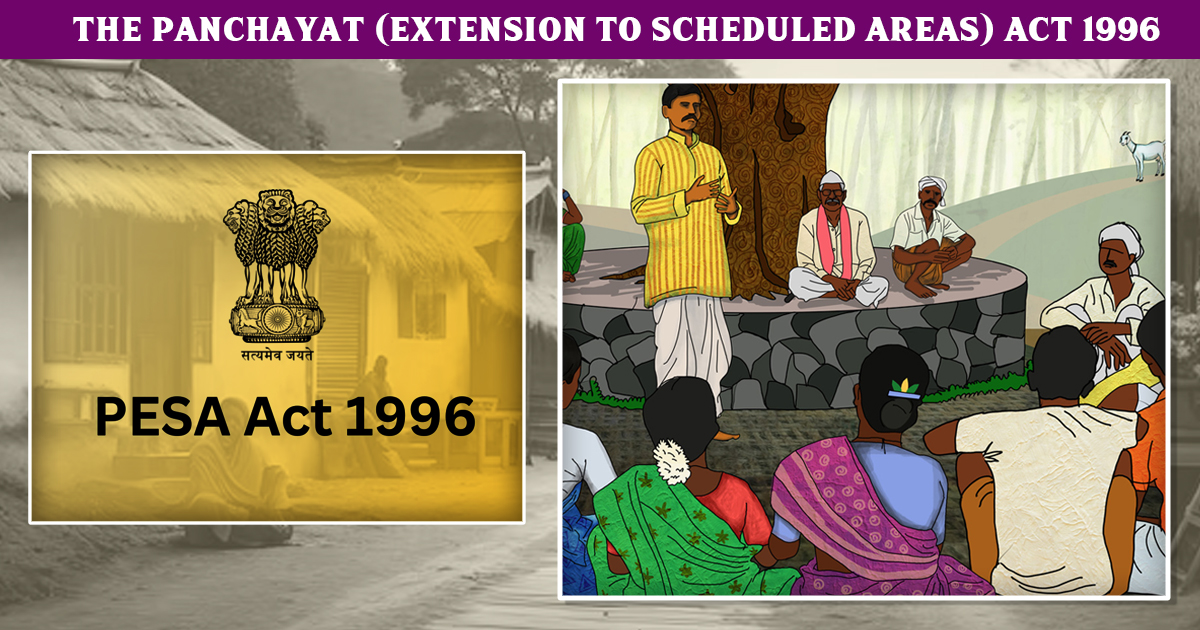
The PESA Act 1996 was enacted to empower Scheduled Tribes by recognizing them as key political stakeholders.
Historical Background:
- Tribal communities in India have faced marginalization and exclusion from mainstream political and economic systems.
- They have encountered challenges such as displacement, loss of land and resources, and cultural erosion.
- The PESA Act 1996 was introduced in response to the tribal communities’ demands for greater autonomy and control over their affairs.
- It is inspired by the 73rd and 74th amendments of the Indian Constitution.
- The Act extends the provisions of Part IX of the Indian Constitution, relating to Panchayats, to Scheduled Areas with specific modifications.
Significant Provisions of the PESA Act 1996:
- Gram Sabha: Establishes the Gram Sabha as a forum for community participation in the development process. The Gram Sabha is responsible for identifying development projects, preparing development plans, and implementing these plans.
- Consultation: Requires consultation with the Gram Sabha before undertaking any development projects or activities in Scheduled Areas.
- Funds: Allows the transfer of funds to the Gram Sabha and Gram Panchayat to enable them to perform their functions.
- Land: Protects the land rights of tribal communities in Scheduled Areas and requires their consent before any land is acquired or transferred.
- Cultural and Social Practices: Protects the cultural and social practices of tribal communities and prohibits interference in these practices.
Applicability of the PESA Act 1996:
- The Act is currently applicable in 10 states with Fifth Schedule Areas: Andhra Pradesh, Telangana, Chhattisgarh, Gujarat, Himachal Pradesh, Jharkhand, Madhya Pradesh, Maharashtra, Odisha, and Rajasthan.
Role of PESA in Forest Conservation:
- Empowerment: Empowers tribal communities by giving them a greater say in the development process.
- Control Over Resources: Grants tribal communities control over the management and utilization of natural resources such as land, water, and forests.
- Protection of Land Rights: Requires Gram Sabha consent before any land is acquired or transferred.
- Sustainable Development: Enables local communities, who have lived in harmony with nature for centuries, to manage resources sustainably.
- Ensuring Benefits: Mandates that Gram Sabhas play a crucial role in identifying beneficiaries for various government schemes.
- Preservation of Practices: Helps protect the cultural and social practices of tribal communities.
- Promotion of Decentralization: Promotes decentralization by giving more powers and functions to the Gram Sabha and Gram Panchayat.
- Improved Access to Services: Contributes to improved access to basic services such as education, healthcare, and drinking water in Scheduled Areas.
Limitations of the PESA Act 1996:
- Limited coverage
- Lack of awareness
- Limited resources
- Lack of trained personnel
- Political interference
- Conflicts with other laws
Suggested Measures for Effective Implementation:
- Convergence of Laws: Integrate the Forest Rights Act (2006), the Right to Fair Compensation and Transparency in Land Acquisition, Rehabilitation and Resettlement Act (2013), and other relevant laws with the PESA Act.
- Objective Role Allocation: Clearly define the roles of the Ministry of Panchayati Raj and the Ministry of Tribal Affairs in implementing the PESA Act.




